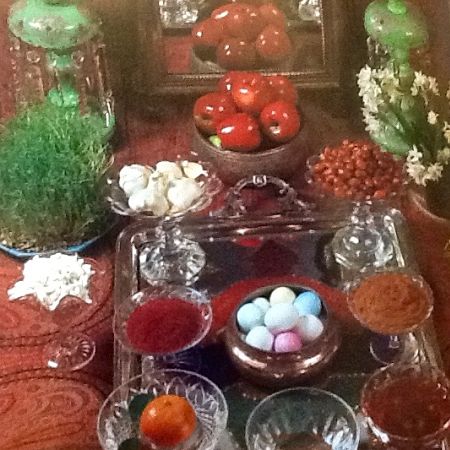 What started as a quick question about an egg tradition hatched into this lovely guest post from Taraneh Hill, who has been an unflagging supporter of cultural diversity and friendship since she emigrated from Persia to Indiana.
What started as a quick question about an egg tradition hatched into this lovely guest post from Taraneh Hill, who has been an unflagging supporter of cultural diversity and friendship since she emigrated from Persia to Indiana.
The festival of Norooz (or Nowruz) marks the Persian New Year. It takes place on the Vernal Equinox and, like many ancient Spring festivals, celebrates the renewal of nature, as well as peace, family, and friendship. An official UN observance, the holiday promotes reconciliation, neighborliness, and friendship among peoples and different communities. Cheers to that and to Mrs. Hill. — VP
It is with pleasure that I write my fondest memories of my culture that has left a void in my heart.
In every household a special cover is spread on a carpet or on a table. This ceremonial setting is called Sofreh-ye haft sinn (literally ” seven dishes’ setting,” each one beginning with the Persian letter sinn (letter s).
The number seven has been sacred in Iran since antiquity, and the seven dishes stand for the seven angelic heralds of life — rebirth, health, happiness, prosperity, joy, patience, and beauty.
To reconfirm the hopes and wishes expressed by the traditional foods, other elements and symbols are also placed on the sofreh. Books of tradition and wisdom are laid out: usually a copy of the holy Koran, or the poems of Hafez. A few coins, representing wealth, and a basket of painted eggs, representing fertility.
A orange floating in a bowl of water represents the earth floating in space, and the fish in a bowl of water represents Anahita, one of the Angels of water and fertility which is the main purpose of the Norooz celebration.
New life, new beginning.
Traditionally in our family, a few hours prior to the transition to the new year we sat around the sofreh-ye haft sinn. Some sang traditional songs and some recited poem of Hafez and verses from Koran. My mother often would say make a wish so that she could ask Hafez about our fortune. Then she would run her fingers through the pages with her eyes closed she would be silent for a moment, and finally she would open the book by placing her fingernail randomly into the pages.
“A gentle breeze will blow a new vitality to the barren earth
The old will become young…
O Swayer of our hearts and sight
A governor of days and nights
O Swayer of feelings and thoughts
Turn our feelings to the best possible”
After spring has started, traditionally, the oldest person begins the well-wishing by standing up and giving out sweets, pastries, coins, and hugs.
During the first few days, it is the younger members to show their respect. The children receive gifts, usually crisp new money; in America dollar bills. There is much singing, dancing, eating, picnics, and drinking. With this, the Norooz celebrations are completed.
“Norooz is coming, so dispel the night from your dark heart;
Norooz will give it light.
Keep her traditions, so that God may bring blissful renewal to us with the Spring.
Poet said.”
Norooz Mobarak
— Guest post by Taraneh Hill, who also provided the lovely photo of a traditional Norooz celebration Sofreh-ye haft sinn table.
Leave a Reply